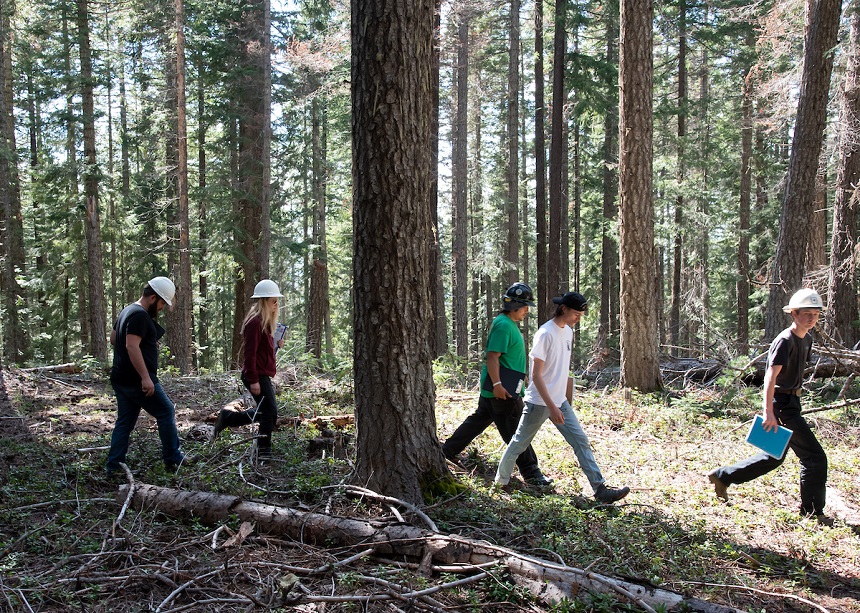Branching Out with Forestry Studies
Oct. 1, 2022
An education in COCC’s Forest Resources Technology program includes open-air learning, an on-site arboretum and career inroads
It’s an autumn afternoon on the woodsy, sprawling Bend campus of Central Oregon Community
College (COCC), and just beyond the library, a class of 14 forestry students is confronting
a known tree thief. That’s what “Phoradendron,” the genus of mistletoe, translates
to from its Greek roots — an apt description for a plant that pirates water and sugars
from trees.
“It’s not a fungus or a lichen, it’s a flowering plant,” explained Rebecca Franklin,
Ph.D., a professor in the college’s Forest Resources Technology program, standing beside a young ponderosa pine and pointing to little yellowy sprouts of
Arceuthobium campylopodum, a species of dwarf mistletoe, that bloom in the branches.
“It uses the ‘pondo’ as its host.”
Many conifer species have a unique, accompanying dwarf mistletoe species specific
to their host, Franklin informs the dendrology class. They differ from the Christmastime
variety in that the holiday sprigs have larger, fuller leaves. Dwarf mistletoes have
barely any leafy parts at all, and generally cause tree limbs to swell and deform.
With an obvious energy for trees and a fun, engaging manner, Franklin, with a set
of red-handled bypass pruners sheathed on her belt, shows her students how to witness
the plant’s seed dispersal in action. Cupped in hands, and with a puff of warm breath
applied, the dwarf mistletoe pops its seeds. The students laugh and marvel at the
science, then hike on again, back on the hunt for thieves.
From dendrology — the study of trees — and fire science to forest preservation and
wildlife management, the COCC Forest Resources Technology program taps into a diverse
and immersive curriculum. The training is configured mostly around labs and field
trips. For instance, the dendrology class will visit 10 sites during the term, from
an old-growth forest along the Willamette National Forest’s Hackleman Creek to the
tree-studded slopes of Pine Mountain.
And it’s a unique education: COCC’s is one of only two associate degree programs in
Oregon accredited by the Society of American Foresters, and one of just eight accredited
programs west of the Mississippi. With an on-site arboretum and a fully equipped lab,
plus a forestry club that facilitates state conference participation, the program
has the resources to support and inspire futures in the field of forestry.
Students can earn six different certificates — advanced forest concepts, cartography,
conservation, ecology, forest measurements and forest protection — and one of two
types of degrees: an Associate of Applied Science in Forest Resources Technology or
an Associate of Science degree in Natural Resources, Forestry or Agricultural Sciences.
The latter type preps students for a four-year degree path at Oregon State University.
Early on at COCC, there’s focus on workplace readiness. “We have a requirement, a
co-op work experience, that requires students to go out and get 300 hours of work,
the equivalent of a summer,” explained Michael Fisher, Ph.D., instructional dean,
who began his own forestry career as a COCC student. “Generally speaking, that’s built
around the concept of people going to work for the Forest Service, the primary employer
of our folks.” Students, through fighting fire or other forest-based skill development,
such as bumblebee research, fulfill this part of the program during their first summer.
Kayla Herriman graduated from the program and went on to receive her master’s degree
in forest resources from the University of Idaho. Having managed the Region 6 Seed
Extractory — a Bend-based U.S. Forest Service facility within the National Forest
Nursery system — for a number of years, “working with seed from across the United
States from more than 4,000 different species of grasses, forbs, shrubs and trees”
to assist with restoration and research, Herriman was recently promoted to national
seed specialist for the Forest Service.
“I got my first Forest Service job doing stand exams because I knew how to use all
of the equipment,” she said. “The foundational skills I learned at COCC were instrumental
in getting me here.”
Back on the Bend campus, professor Franklin gathers her dendrology class beneath a
towering paperbark birch to discuss leafage. “Let’s think about the patterns of those
veins,” she said, holding up a serrated-edged leaf from the birch. Leaf veins, she
explained, transport sugars and water and can be either classified as pinnately veined
(with veins branching out from a central vein), such as the birch’s leaf, or palmately
veined (a pattern that resembles an open hand), represented by the leaf of a nearby
vine maple. “Those are the two main vein patterns we see.”
Soon, she’s kneeling on the ground and showing the class — who have been collecting
leaf and needle samples at each stop of their open-air lab — how to press their specimens
with their portable, water-absorbing plant presses. It will keep their findings from
rotting, requiring a week’s time for the samples to dry. But the class is already
on the move again, heading for a group of apple trees and another interactive lesson
in the leafy world.
For more details on the Forest Resources Technology program, visit cocc.edu/programs/forestry or call 541-383-7700.
By Mark Russell Johnson, COCC Staff Writer

